Organisational Behaviour and Leadership: A Critical Analysis Essay
VerifiedAdded on 2022/08/22
|14
|3663
|13
Essay
AI Summary
This essay delves into the multifaceted realm of organisational behaviour and leadership, providing a comprehensive analysis of key theories and their practical applications. It examines the interrelation of organisational behaviour and human resource development, highlighting the challenges companies face in adapting to a diverse workforce. The essay explores essential concepts such as organisational culture, effectiveness, and learning, with a focus on leadership's role in achieving business goals and inspiring employees. It critically analyses various leadership theories, including trait, contingency, and situational leadership, evaluating their impact on organisational performance. The discussion also covers different leadership styles, such as transformational, democratic, and autocratic, assessing their respective contributions to business outcomes. The essay underscores the importance of effective leadership in fostering employee morale, driving innovation, and creating a positive corporate culture, while also acknowledging the potential negative impacts of poor leadership. This assignment is a critical appraisal of the contributions of various theories to our understanding of human behaviour in organisational settings.
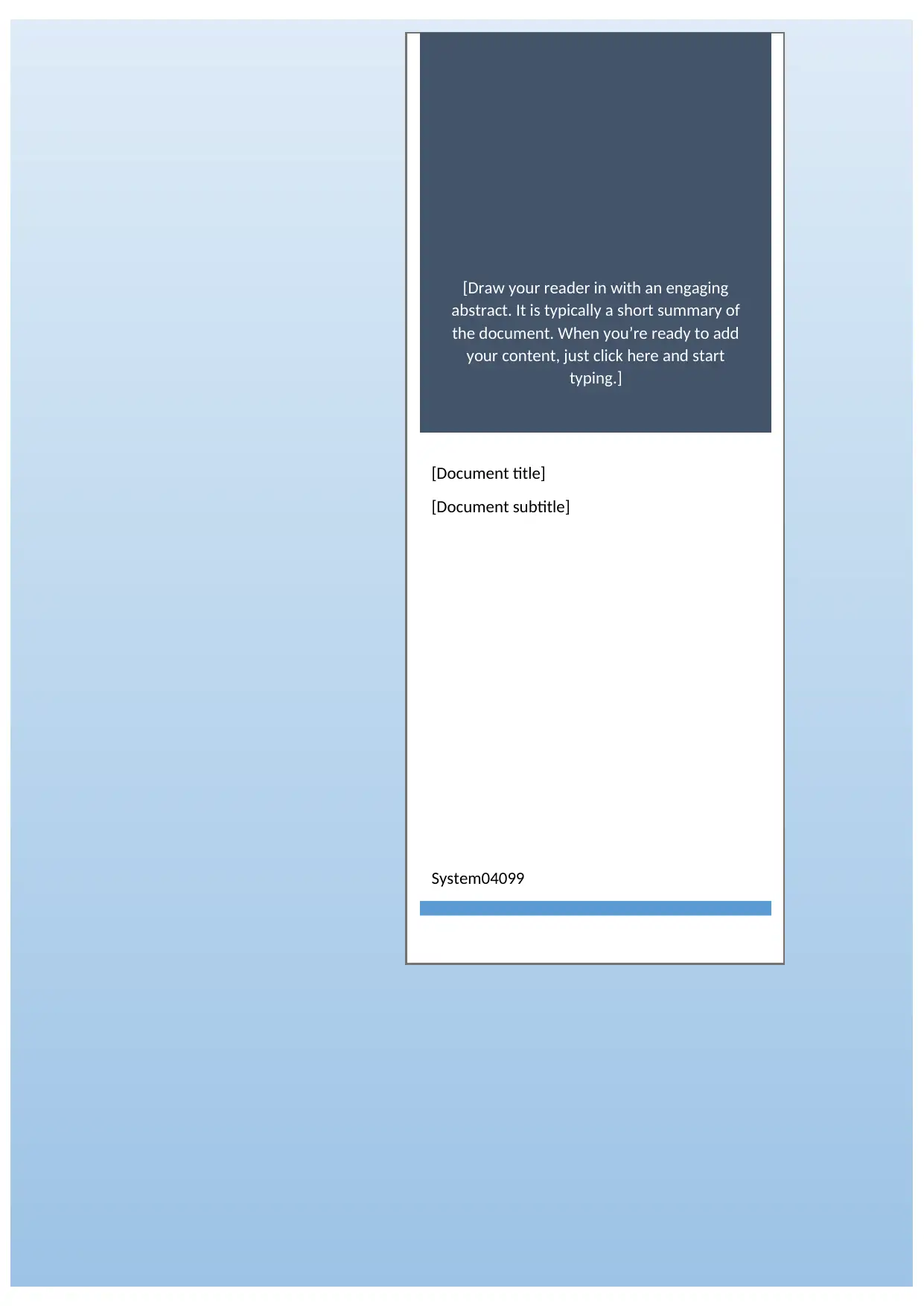
[Draw your reader in with an engaging
abstract. It is typically a short summary of
the document. When you’re ready to add
your content, just click here and start
typing.]
[Document title]
[Document subtitle]
System04099
abstract. It is typically a short summary of
the document. When you’re ready to add
your content, just click here and start
typing.]
[Document title]
[Document subtitle]
System04099
Paraphrase This Document
Need a fresh take? Get an instant paraphrase of this document with our AI Paraphraser

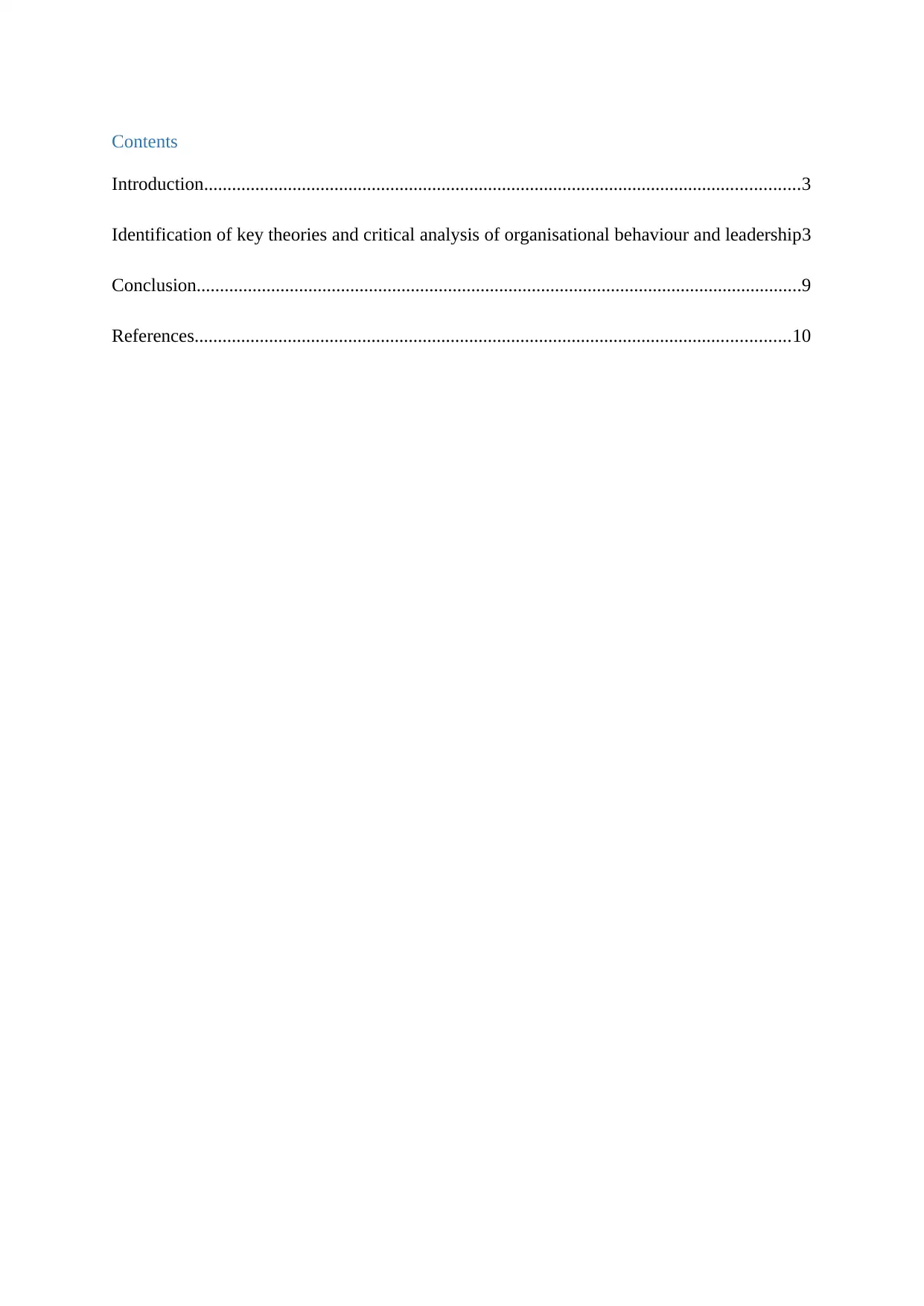
Contents
Introduction................................................................................................................................3
Identification of key theories and critical analysis of organisational behaviour and leadership3
Conclusion..................................................................................................................................9
References................................................................................................................................10
Introduction................................................................................................................................3
Identification of key theories and critical analysis of organisational behaviour and leadership3
Conclusion..................................................................................................................................9
References................................................................................................................................10
⊘ This is a preview!⊘
Do you want full access?
Subscribe today to unlock all pages.

Trusted by 1+ million students worldwide
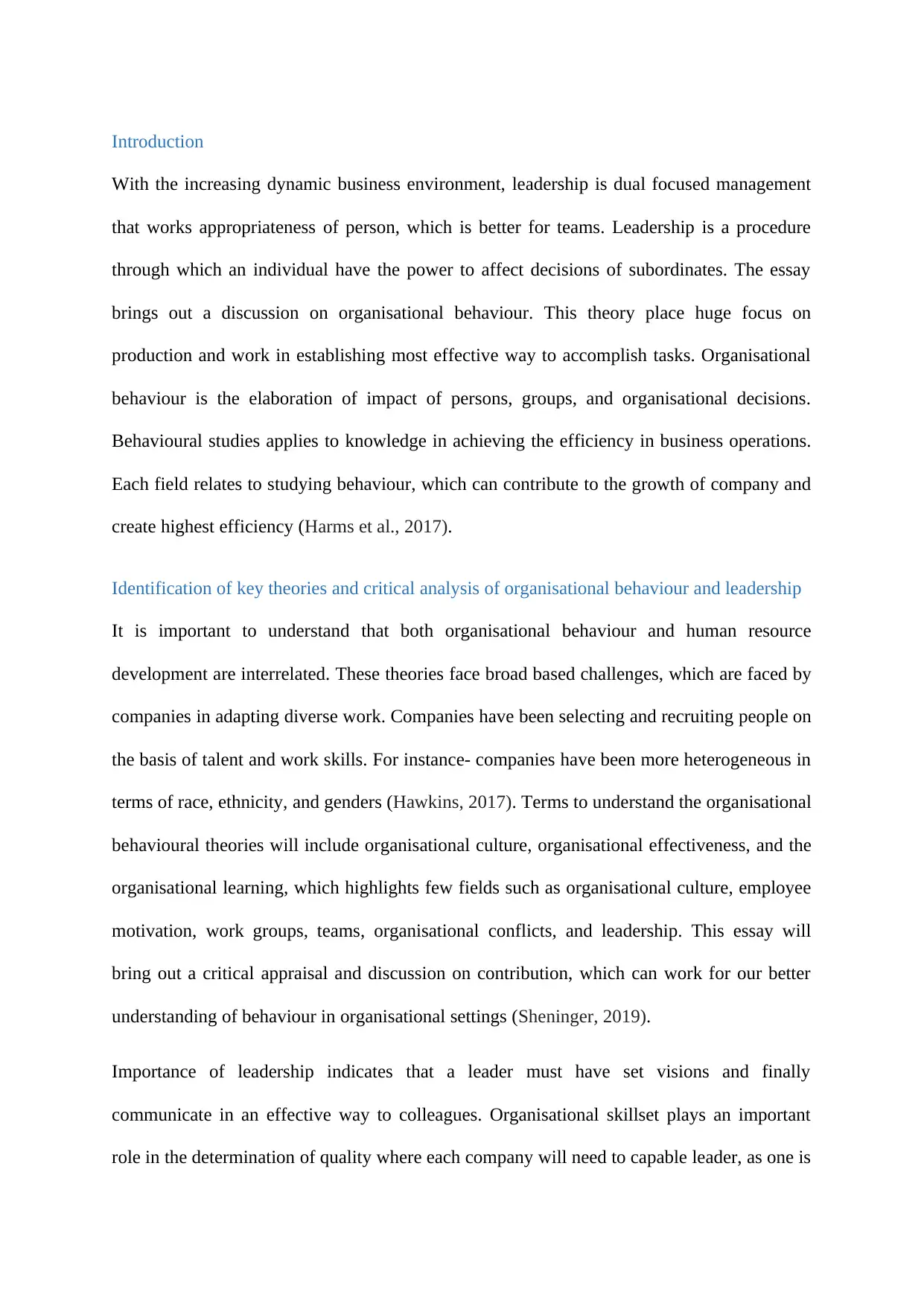
Introduction
With the increasing dynamic business environment, leadership is dual focused management
that works appropriateness of person, which is better for teams. Leadership is a procedure
through which an individual have the power to affect decisions of subordinates. The essay
brings out a discussion on organisational behaviour. This theory place huge focus on
production and work in establishing most effective way to accomplish tasks. Organisational
behaviour is the elaboration of impact of persons, groups, and organisational decisions.
Behavioural studies applies to knowledge in achieving the efficiency in business operations.
Each field relates to studying behaviour, which can contribute to the growth of company and
create highest efficiency (Harms et al., 2017).
Identification of key theories and critical analysis of organisational behaviour and leadership
It is important to understand that both organisational behaviour and human resource
development are interrelated. These theories face broad based challenges, which are faced by
companies in adapting diverse work. Companies have been selecting and recruiting people on
the basis of talent and work skills. For instance- companies have been more heterogeneous in
terms of race, ethnicity, and genders (Hawkins, 2017). Terms to understand the organisational
behavioural theories will include organisational culture, organisational effectiveness, and the
organisational learning, which highlights few fields such as organisational culture, employee
motivation, work groups, teams, organisational conflicts, and leadership. This essay will
bring out a critical appraisal and discussion on contribution, which can work for our better
understanding of behaviour in organisational settings (Sheninger, 2019).
Importance of leadership indicates that a leader must have set visions and finally
communicate in an effective way to colleagues. Organisational skillset plays an important
role in the determination of quality where each company will need to capable leader, as one is
With the increasing dynamic business environment, leadership is dual focused management
that works appropriateness of person, which is better for teams. Leadership is a procedure
through which an individual have the power to affect decisions of subordinates. The essay
brings out a discussion on organisational behaviour. This theory place huge focus on
production and work in establishing most effective way to accomplish tasks. Organisational
behaviour is the elaboration of impact of persons, groups, and organisational decisions.
Behavioural studies applies to knowledge in achieving the efficiency in business operations.
Each field relates to studying behaviour, which can contribute to the growth of company and
create highest efficiency (Harms et al., 2017).
Identification of key theories and critical analysis of organisational behaviour and leadership
It is important to understand that both organisational behaviour and human resource
development are interrelated. These theories face broad based challenges, which are faced by
companies in adapting diverse work. Companies have been selecting and recruiting people on
the basis of talent and work skills. For instance- companies have been more heterogeneous in
terms of race, ethnicity, and genders (Hawkins, 2017). Terms to understand the organisational
behavioural theories will include organisational culture, organisational effectiveness, and the
organisational learning, which highlights few fields such as organisational culture, employee
motivation, work groups, teams, organisational conflicts, and leadership. This essay will
bring out a critical appraisal and discussion on contribution, which can work for our better
understanding of behaviour in organisational settings (Sheninger, 2019).
Importance of leadership indicates that a leader must have set visions and finally
communicate in an effective way to colleagues. Organisational skillset plays an important
role in the determination of quality where each company will need to capable leader, as one is
Paraphrase This Document
Need a fresh take? Get an instant paraphrase of this document with our AI Paraphraser
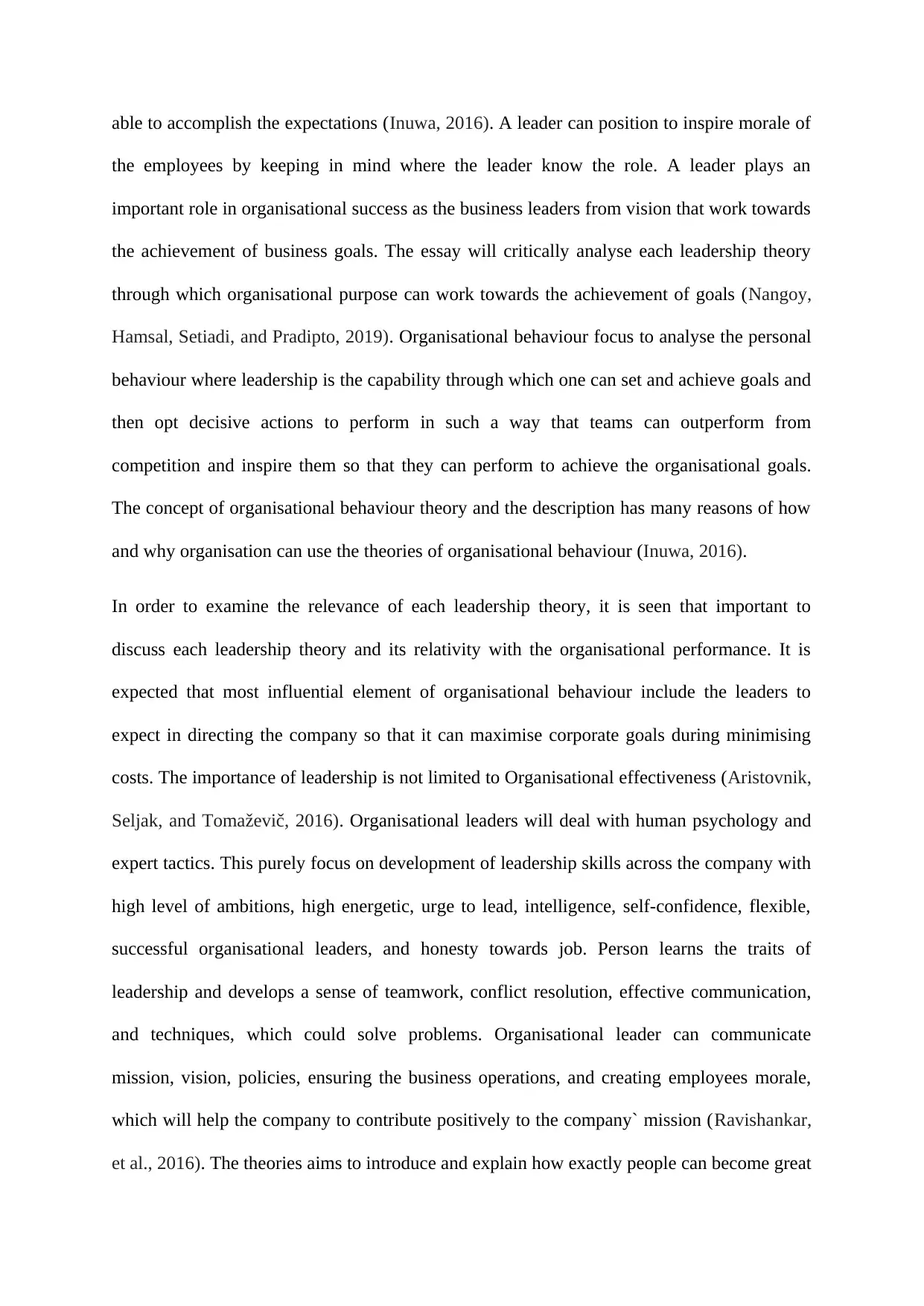
able to accomplish the expectations (Inuwa, 2016). A leader can position to inspire morale of
the employees by keeping in mind where the leader know the role. A leader plays an
important role in organisational success as the business leaders from vision that work towards
the achievement of business goals. The essay will critically analyse each leadership theory
through which organisational purpose can work towards the achievement of goals (Nangoy,
Hamsal, Setiadi, and Pradipto, 2019). Organisational behaviour focus to analyse the personal
behaviour where leadership is the capability through which one can set and achieve goals and
then opt decisive actions to perform in such a way that teams can outperform from
competition and inspire them so that they can perform to achieve the organisational goals.
The concept of organisational behaviour theory and the description has many reasons of how
and why organisation can use the theories of organisational behaviour (Inuwa, 2016).
In order to examine the relevance of each leadership theory, it is seen that important to
discuss each leadership theory and its relativity with the organisational performance. It is
expected that most influential element of organisational behaviour include the leaders to
expect in directing the company so that it can maximise corporate goals during minimising
costs. The importance of leadership is not limited to Organisational effectiveness (Aristovnik,
Seljak, and Tomaževič, 2016). Organisational leaders will deal with human psychology and
expert tactics. This purely focus on development of leadership skills across the company with
high level of ambitions, high energetic, urge to lead, intelligence, self-confidence, flexible,
successful organisational leaders, and honesty towards job. Person learns the traits of
leadership and develops a sense of teamwork, conflict resolution, effective communication,
and techniques, which could solve problems. Organisational leader can communicate
mission, vision, policies, ensuring the business operations, and creating employees morale,
which will help the company to contribute positively to the company` mission (Ravishankar,
et al., 2016). The theories aims to introduce and explain how exactly people can become great
the employees by keeping in mind where the leader know the role. A leader plays an
important role in organisational success as the business leaders from vision that work towards
the achievement of business goals. The essay will critically analyse each leadership theory
through which organisational purpose can work towards the achievement of goals (Nangoy,
Hamsal, Setiadi, and Pradipto, 2019). Organisational behaviour focus to analyse the personal
behaviour where leadership is the capability through which one can set and achieve goals and
then opt decisive actions to perform in such a way that teams can outperform from
competition and inspire them so that they can perform to achieve the organisational goals.
The concept of organisational behaviour theory and the description has many reasons of how
and why organisation can use the theories of organisational behaviour (Inuwa, 2016).
In order to examine the relevance of each leadership theory, it is seen that important to
discuss each leadership theory and its relativity with the organisational performance. It is
expected that most influential element of organisational behaviour include the leaders to
expect in directing the company so that it can maximise corporate goals during minimising
costs. The importance of leadership is not limited to Organisational effectiveness (Aristovnik,
Seljak, and Tomaževič, 2016). Organisational leaders will deal with human psychology and
expert tactics. This purely focus on development of leadership skills across the company with
high level of ambitions, high energetic, urge to lead, intelligence, self-confidence, flexible,
successful organisational leaders, and honesty towards job. Person learns the traits of
leadership and develops a sense of teamwork, conflict resolution, effective communication,
and techniques, which could solve problems. Organisational leader can communicate
mission, vision, policies, ensuring the business operations, and creating employees morale,
which will help the company to contribute positively to the company` mission (Ravishankar,
et al., 2016). The theories aims to introduce and explain how exactly people can become great
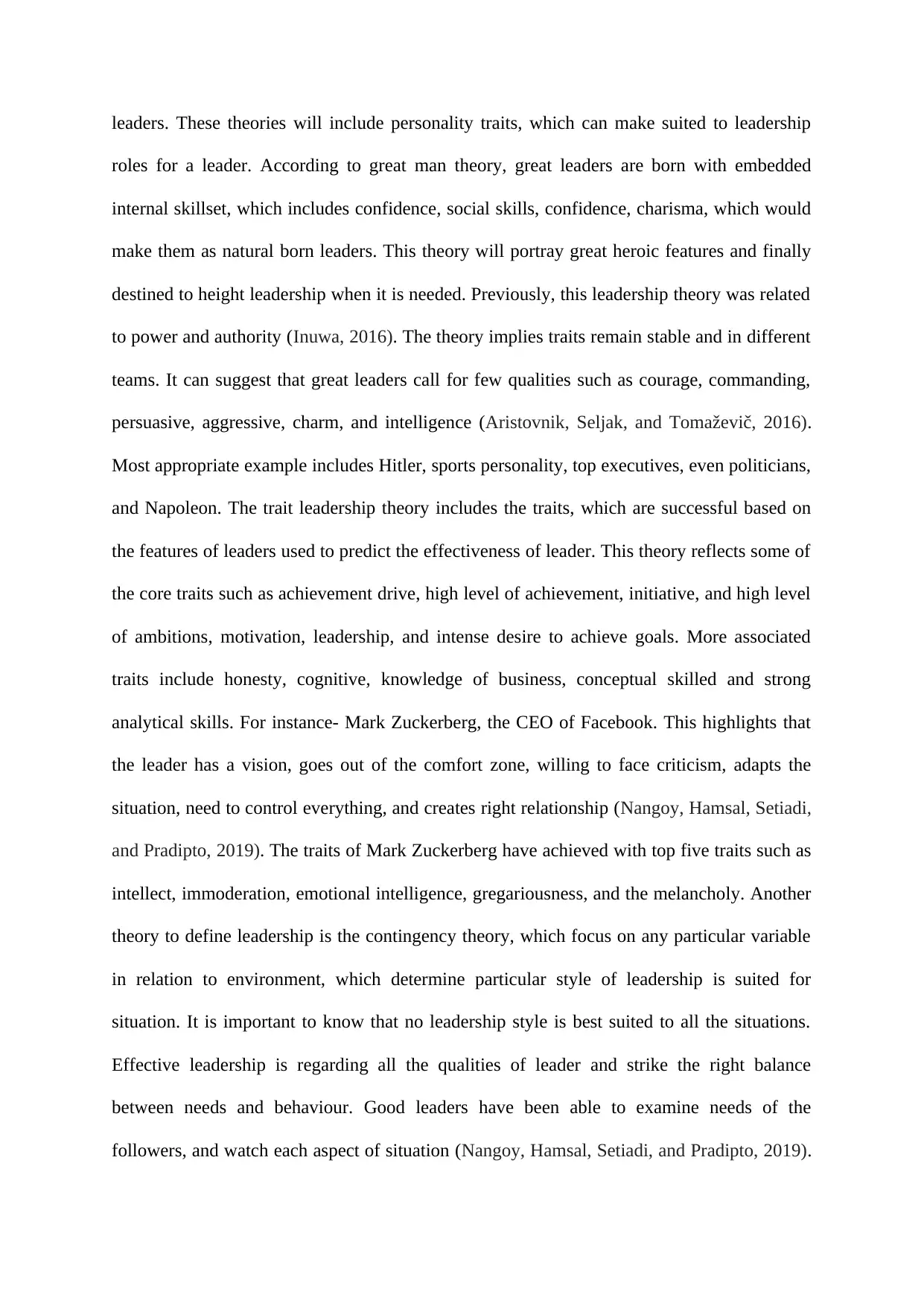
leaders. These theories will include personality traits, which can make suited to leadership
roles for a leader. According to great man theory, great leaders are born with embedded
internal skillset, which includes confidence, social skills, confidence, charisma, which would
make them as natural born leaders. This theory will portray great heroic features and finally
destined to height leadership when it is needed. Previously, this leadership theory was related
to power and authority (Inuwa, 2016). The theory implies traits remain stable and in different
teams. It can suggest that great leaders call for few qualities such as courage, commanding,
persuasive, aggressive, charm, and intelligence (Aristovnik, Seljak, and Tomaževič, 2016).
Most appropriate example includes Hitler, sports personality, top executives, even politicians,
and Napoleon. The trait leadership theory includes the traits, which are successful based on
the features of leaders used to predict the effectiveness of leader. This theory reflects some of
the core traits such as achievement drive, high level of achievement, initiative, and high level
of ambitions, motivation, leadership, and intense desire to achieve goals. More associated
traits include honesty, cognitive, knowledge of business, conceptual skilled and strong
analytical skills. For instance- Mark Zuckerberg, the CEO of Facebook. This highlights that
the leader has a vision, goes out of the comfort zone, willing to face criticism, adapts the
situation, need to control everything, and creates right relationship (Nangoy, Hamsal, Setiadi,
and Pradipto, 2019). The traits of Mark Zuckerberg have achieved with top five traits such as
intellect, immoderation, emotional intelligence, gregariousness, and the melancholy. Another
theory to define leadership is the contingency theory, which focus on any particular variable
in relation to environment, which determine particular style of leadership is suited for
situation. It is important to know that no leadership style is best suited to all the situations.
Effective leadership is regarding all the qualities of leader and strike the right balance
between needs and behaviour. Good leaders have been able to examine needs of the
followers, and watch each aspect of situation (Nangoy, Hamsal, Setiadi, and Pradipto, 2019).
roles for a leader. According to great man theory, great leaders are born with embedded
internal skillset, which includes confidence, social skills, confidence, charisma, which would
make them as natural born leaders. This theory will portray great heroic features and finally
destined to height leadership when it is needed. Previously, this leadership theory was related
to power and authority (Inuwa, 2016). The theory implies traits remain stable and in different
teams. It can suggest that great leaders call for few qualities such as courage, commanding,
persuasive, aggressive, charm, and intelligence (Aristovnik, Seljak, and Tomaževič, 2016).
Most appropriate example includes Hitler, sports personality, top executives, even politicians,
and Napoleon. The trait leadership theory includes the traits, which are successful based on
the features of leaders used to predict the effectiveness of leader. This theory reflects some of
the core traits such as achievement drive, high level of achievement, initiative, and high level
of ambitions, motivation, leadership, and intense desire to achieve goals. More associated
traits include honesty, cognitive, knowledge of business, conceptual skilled and strong
analytical skills. For instance- Mark Zuckerberg, the CEO of Facebook. This highlights that
the leader has a vision, goes out of the comfort zone, willing to face criticism, adapts the
situation, need to control everything, and creates right relationship (Nangoy, Hamsal, Setiadi,
and Pradipto, 2019). The traits of Mark Zuckerberg have achieved with top five traits such as
intellect, immoderation, emotional intelligence, gregariousness, and the melancholy. Another
theory to define leadership is the contingency theory, which focus on any particular variable
in relation to environment, which determine particular style of leadership is suited for
situation. It is important to know that no leadership style is best suited to all the situations.
Effective leadership is regarding all the qualities of leader and strike the right balance
between needs and behaviour. Good leaders have been able to examine needs of the
followers, and watch each aspect of situation (Nangoy, Hamsal, Setiadi, and Pradipto, 2019).
⊘ This is a preview!⊘
Do you want full access?
Subscribe today to unlock all pages.

Trusted by 1+ million students worldwide
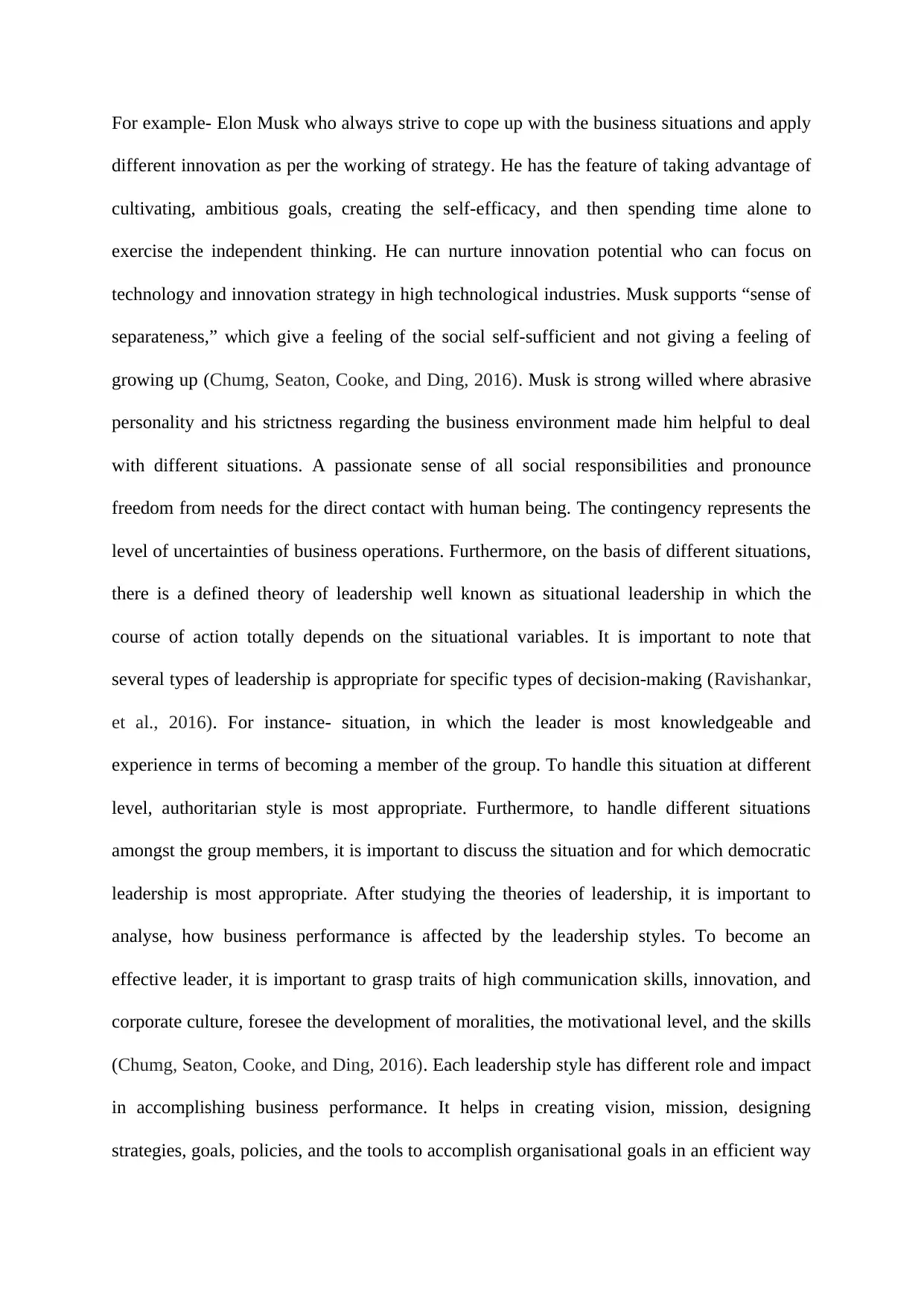
For example- Elon Musk who always strive to cope up with the business situations and apply
different innovation as per the working of strategy. He has the feature of taking advantage of
cultivating, ambitious goals, creating the self-efficacy, and then spending time alone to
exercise the independent thinking. He can nurture innovation potential who can focus on
technology and innovation strategy in high technological industries. Musk supports “sense of
separateness,” which give a feeling of the social self-sufficient and not giving a feeling of
growing up (Chumg, Seaton, Cooke, and Ding, 2016). Musk is strong willed where abrasive
personality and his strictness regarding the business environment made him helpful to deal
with different situations. A passionate sense of all social responsibilities and pronounce
freedom from needs for the direct contact with human being. The contingency represents the
level of uncertainties of business operations. Furthermore, on the basis of different situations,
there is a defined theory of leadership well known as situational leadership in which the
course of action totally depends on the situational variables. It is important to note that
several types of leadership is appropriate for specific types of decision-making (Ravishankar,
et al., 2016). For instance- situation, in which the leader is most knowledgeable and
experience in terms of becoming a member of the group. To handle this situation at different
level, authoritarian style is most appropriate. Furthermore, to handle different situations
amongst the group members, it is important to discuss the situation and for which democratic
leadership is most appropriate. After studying the theories of leadership, it is important to
analyse, how business performance is affected by the leadership styles. To become an
effective leader, it is important to grasp traits of high communication skills, innovation, and
corporate culture, foresee the development of moralities, the motivational level, and the skills
(Chumg, Seaton, Cooke, and Ding, 2016). Each leadership style has different role and impact
in accomplishing business performance. It helps in creating vision, mission, designing
strategies, goals, policies, and the tools to accomplish organisational goals in an efficient way
different innovation as per the working of strategy. He has the feature of taking advantage of
cultivating, ambitious goals, creating the self-efficacy, and then spending time alone to
exercise the independent thinking. He can nurture innovation potential who can focus on
technology and innovation strategy in high technological industries. Musk supports “sense of
separateness,” which give a feeling of the social self-sufficient and not giving a feeling of
growing up (Chumg, Seaton, Cooke, and Ding, 2016). Musk is strong willed where abrasive
personality and his strictness regarding the business environment made him helpful to deal
with different situations. A passionate sense of all social responsibilities and pronounce
freedom from needs for the direct contact with human being. The contingency represents the
level of uncertainties of business operations. Furthermore, on the basis of different situations,
there is a defined theory of leadership well known as situational leadership in which the
course of action totally depends on the situational variables. It is important to note that
several types of leadership is appropriate for specific types of decision-making (Ravishankar,
et al., 2016). For instance- situation, in which the leader is most knowledgeable and
experience in terms of becoming a member of the group. To handle this situation at different
level, authoritarian style is most appropriate. Furthermore, to handle different situations
amongst the group members, it is important to discuss the situation and for which democratic
leadership is most appropriate. After studying the theories of leadership, it is important to
analyse, how business performance is affected by the leadership styles. To become an
effective leader, it is important to grasp traits of high communication skills, innovation, and
corporate culture, foresee the development of moralities, the motivational level, and the skills
(Chumg, Seaton, Cooke, and Ding, 2016). Each leadership style has different role and impact
in accomplishing business performance. It helps in creating vision, mission, designing
strategies, goals, policies, and the tools to accomplish organisational goals in an efficient way
Paraphrase This Document
Need a fresh take? Get an instant paraphrase of this document with our AI Paraphraser
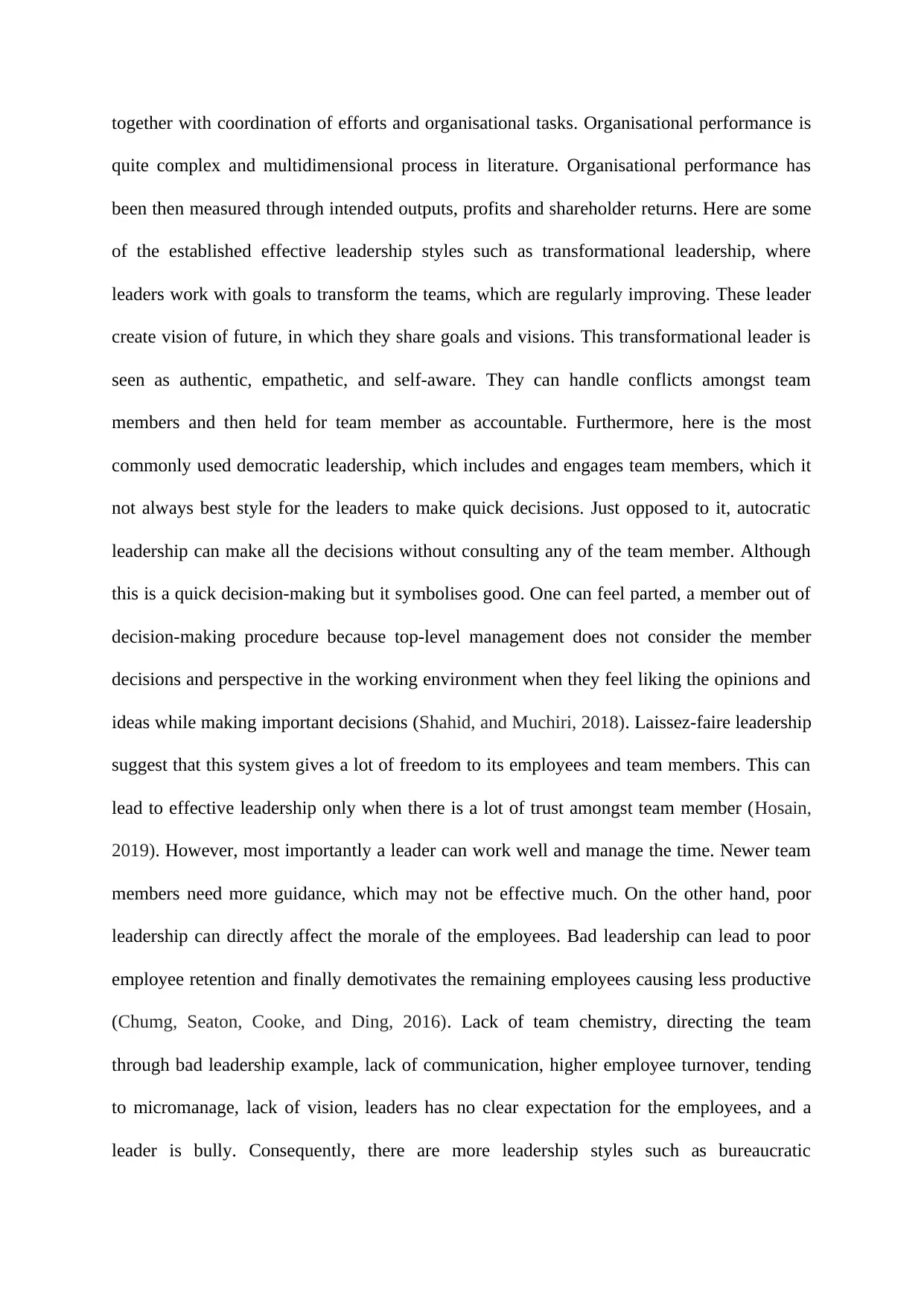
together with coordination of efforts and organisational tasks. Organisational performance is
quite complex and multidimensional process in literature. Organisational performance has
been then measured through intended outputs, profits and shareholder returns. Here are some
of the established effective leadership styles such as transformational leadership, where
leaders work with goals to transform the teams, which are regularly improving. These leader
create vision of future, in which they share goals and visions. This transformational leader is
seen as authentic, empathetic, and self-aware. They can handle conflicts amongst team
members and then held for team member as accountable. Furthermore, here is the most
commonly used democratic leadership, which includes and engages team members, which it
not always best style for the leaders to make quick decisions. Just opposed to it, autocratic
leadership can make all the decisions without consulting any of the team member. Although
this is a quick decision-making but it symbolises good. One can feel parted, a member out of
decision-making procedure because top-level management does not consider the member
decisions and perspective in the working environment when they feel liking the opinions and
ideas while making important decisions (Shahid, and Muchiri, 2018). Laissez-faire leadership
suggest that this system gives a lot of freedom to its employees and team members. This can
lead to effective leadership only when there is a lot of trust amongst team member (Hosain,
2019). However, most importantly a leader can work well and manage the time. Newer team
members need more guidance, which may not be effective much. On the other hand, poor
leadership can directly affect the morale of the employees. Bad leadership can lead to poor
employee retention and finally demotivates the remaining employees causing less productive
(Chumg, Seaton, Cooke, and Ding, 2016). Lack of team chemistry, directing the team
through bad leadership example, lack of communication, higher employee turnover, tending
to micromanage, lack of vision, leaders has no clear expectation for the employees, and a
leader is bully. Consequently, there are more leadership styles such as bureaucratic
quite complex and multidimensional process in literature. Organisational performance has
been then measured through intended outputs, profits and shareholder returns. Here are some
of the established effective leadership styles such as transformational leadership, where
leaders work with goals to transform the teams, which are regularly improving. These leader
create vision of future, in which they share goals and visions. This transformational leader is
seen as authentic, empathetic, and self-aware. They can handle conflicts amongst team
members and then held for team member as accountable. Furthermore, here is the most
commonly used democratic leadership, which includes and engages team members, which it
not always best style for the leaders to make quick decisions. Just opposed to it, autocratic
leadership can make all the decisions without consulting any of the team member. Although
this is a quick decision-making but it symbolises good. One can feel parted, a member out of
decision-making procedure because top-level management does not consider the member
decisions and perspective in the working environment when they feel liking the opinions and
ideas while making important decisions (Shahid, and Muchiri, 2018). Laissez-faire leadership
suggest that this system gives a lot of freedom to its employees and team members. This can
lead to effective leadership only when there is a lot of trust amongst team member (Hosain,
2019). However, most importantly a leader can work well and manage the time. Newer team
members need more guidance, which may not be effective much. On the other hand, poor
leadership can directly affect the morale of the employees. Bad leadership can lead to poor
employee retention and finally demotivates the remaining employees causing less productive
(Chumg, Seaton, Cooke, and Ding, 2016). Lack of team chemistry, directing the team
through bad leadership example, lack of communication, higher employee turnover, tending
to micromanage, lack of vision, leaders has no clear expectation for the employees, and a
leader is bully. Consequently, there are more leadership styles such as bureaucratic
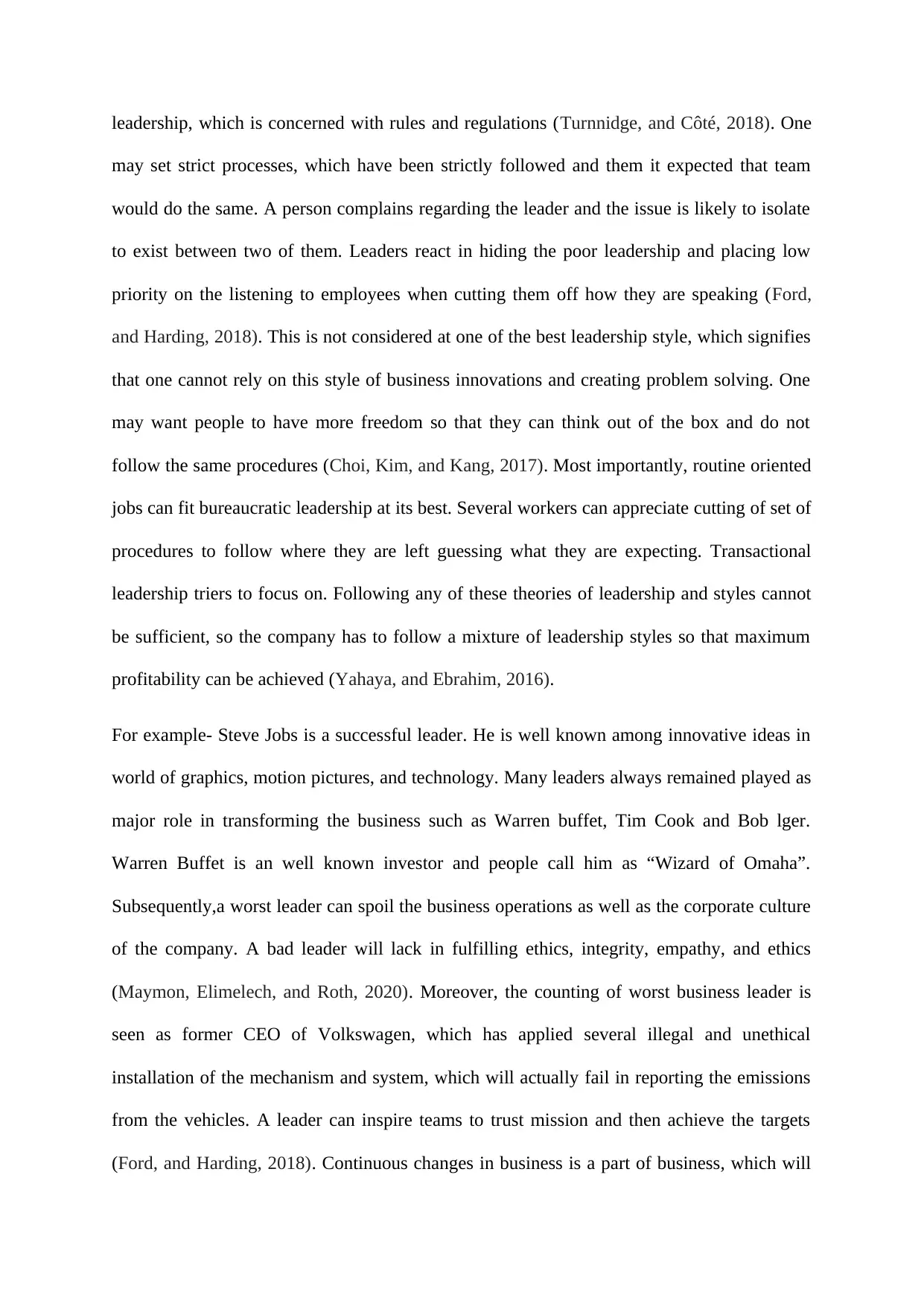
leadership, which is concerned with rules and regulations (Turnnidge, and Côté, 2018). One
may set strict processes, which have been strictly followed and them it expected that team
would do the same. A person complains regarding the leader and the issue is likely to isolate
to exist between two of them. Leaders react in hiding the poor leadership and placing low
priority on the listening to employees when cutting them off how they are speaking (Ford,
and Harding, 2018). This is not considered at one of the best leadership style, which signifies
that one cannot rely on this style of business innovations and creating problem solving. One
may want people to have more freedom so that they can think out of the box and do not
follow the same procedures (Choi, Kim, and Kang, 2017). Most importantly, routine oriented
jobs can fit bureaucratic leadership at its best. Several workers can appreciate cutting of set of
procedures to follow where they are left guessing what they are expecting. Transactional
leadership triers to focus on. Following any of these theories of leadership and styles cannot
be sufficient, so the company has to follow a mixture of leadership styles so that maximum
profitability can be achieved (Yahaya, and Ebrahim, 2016).
For example- Steve Jobs is a successful leader. He is well known among innovative ideas in
world of graphics, motion pictures, and technology. Many leaders always remained played as
major role in transforming the business such as Warren buffet, Tim Cook and Bob lger.
Warren Buffet is an well known investor and people call him as “Wizard of Omaha”.
Subsequently,a worst leader can spoil the business operations as well as the corporate culture
of the company. A bad leader will lack in fulfilling ethics, integrity, empathy, and ethics
(Maymon, Elimelech, and Roth, 2020). Moreover, the counting of worst business leader is
seen as former CEO of Volkswagen, which has applied several illegal and unethical
installation of the mechanism and system, which will actually fail in reporting the emissions
from the vehicles. A leader can inspire teams to trust mission and then achieve the targets
(Ford, and Harding, 2018). Continuous changes in business is a part of business, which will
may set strict processes, which have been strictly followed and them it expected that team
would do the same. A person complains regarding the leader and the issue is likely to isolate
to exist between two of them. Leaders react in hiding the poor leadership and placing low
priority on the listening to employees when cutting them off how they are speaking (Ford,
and Harding, 2018). This is not considered at one of the best leadership style, which signifies
that one cannot rely on this style of business innovations and creating problem solving. One
may want people to have more freedom so that they can think out of the box and do not
follow the same procedures (Choi, Kim, and Kang, 2017). Most importantly, routine oriented
jobs can fit bureaucratic leadership at its best. Several workers can appreciate cutting of set of
procedures to follow where they are left guessing what they are expecting. Transactional
leadership triers to focus on. Following any of these theories of leadership and styles cannot
be sufficient, so the company has to follow a mixture of leadership styles so that maximum
profitability can be achieved (Yahaya, and Ebrahim, 2016).
For example- Steve Jobs is a successful leader. He is well known among innovative ideas in
world of graphics, motion pictures, and technology. Many leaders always remained played as
major role in transforming the business such as Warren buffet, Tim Cook and Bob lger.
Warren Buffet is an well known investor and people call him as “Wizard of Omaha”.
Subsequently,a worst leader can spoil the business operations as well as the corporate culture
of the company. A bad leader will lack in fulfilling ethics, integrity, empathy, and ethics
(Maymon, Elimelech, and Roth, 2020). Moreover, the counting of worst business leader is
seen as former CEO of Volkswagen, which has applied several illegal and unethical
installation of the mechanism and system, which will actually fail in reporting the emissions
from the vehicles. A leader can inspire teams to trust mission and then achieve the targets
(Ford, and Harding, 2018). Continuous changes in business is a part of business, which will
⊘ This is a preview!⊘
Do you want full access?
Subscribe today to unlock all pages.

Trusted by 1+ million students worldwide
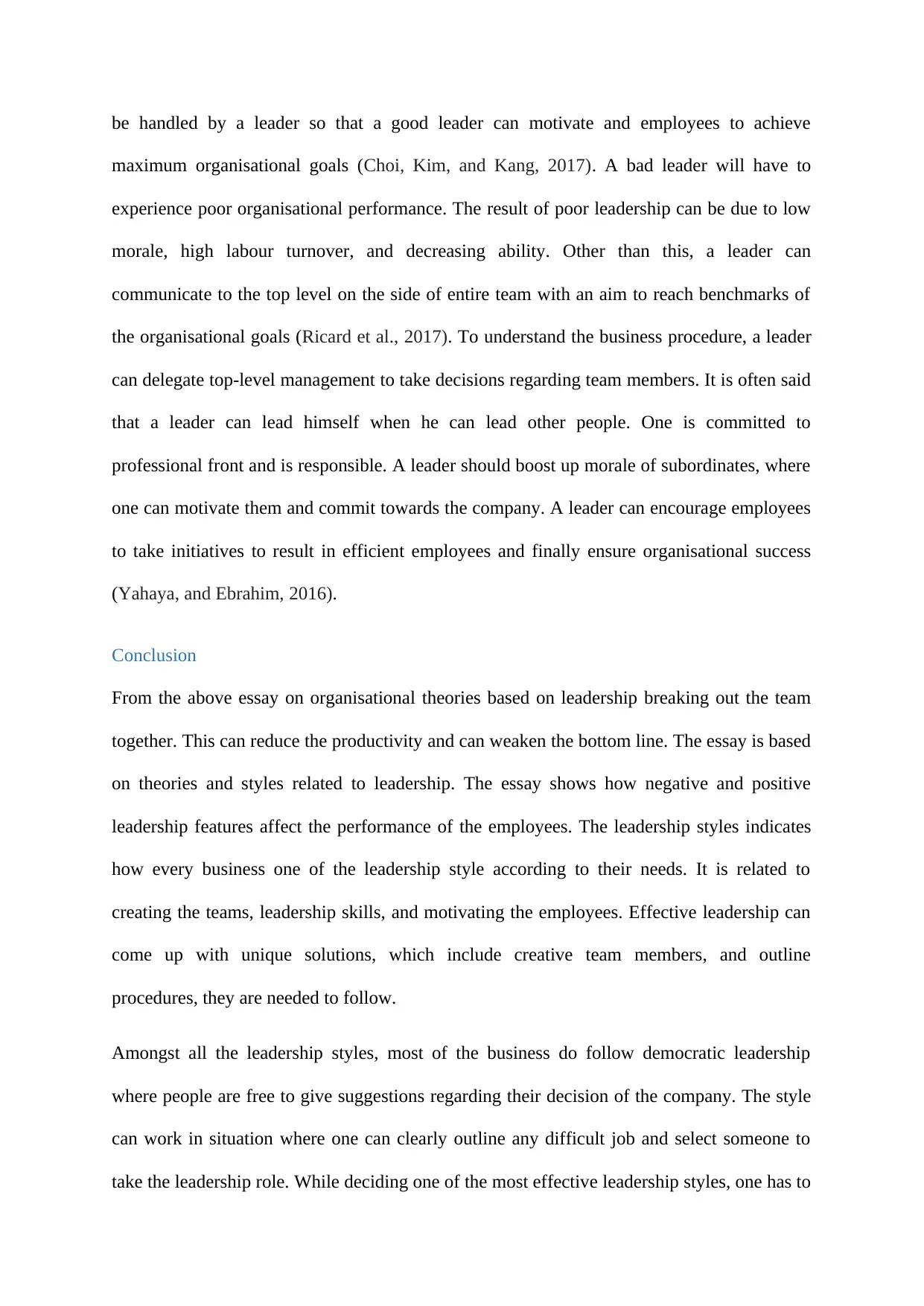
be handled by a leader so that a good leader can motivate and employees to achieve
maximum organisational goals (Choi, Kim, and Kang, 2017). A bad leader will have to
experience poor organisational performance. The result of poor leadership can be due to low
morale, high labour turnover, and decreasing ability. Other than this, a leader can
communicate to the top level on the side of entire team with an aim to reach benchmarks of
the organisational goals (Ricard et al., 2017). To understand the business procedure, a leader
can delegate top-level management to take decisions regarding team members. It is often said
that a leader can lead himself when he can lead other people. One is committed to
professional front and is responsible. A leader should boost up morale of subordinates, where
one can motivate them and commit towards the company. A leader can encourage employees
to take initiatives to result in efficient employees and finally ensure organisational success
(Yahaya, and Ebrahim, 2016).
Conclusion
From the above essay on organisational theories based on leadership breaking out the team
together. This can reduce the productivity and can weaken the bottom line. The essay is based
on theories and styles related to leadership. The essay shows how negative and positive
leadership features affect the performance of the employees. The leadership styles indicates
how every business one of the leadership style according to their needs. It is related to
creating the teams, leadership skills, and motivating the employees. Effective leadership can
come up with unique solutions, which include creative team members, and outline
procedures, they are needed to follow.
Amongst all the leadership styles, most of the business do follow democratic leadership
where people are free to give suggestions regarding their decision of the company. The style
can work in situation where one can clearly outline any difficult job and select someone to
take the leadership role. While deciding one of the most effective leadership styles, one has to
maximum organisational goals (Choi, Kim, and Kang, 2017). A bad leader will have to
experience poor organisational performance. The result of poor leadership can be due to low
morale, high labour turnover, and decreasing ability. Other than this, a leader can
communicate to the top level on the side of entire team with an aim to reach benchmarks of
the organisational goals (Ricard et al., 2017). To understand the business procedure, a leader
can delegate top-level management to take decisions regarding team members. It is often said
that a leader can lead himself when he can lead other people. One is committed to
professional front and is responsible. A leader should boost up morale of subordinates, where
one can motivate them and commit towards the company. A leader can encourage employees
to take initiatives to result in efficient employees and finally ensure organisational success
(Yahaya, and Ebrahim, 2016).
Conclusion
From the above essay on organisational theories based on leadership breaking out the team
together. This can reduce the productivity and can weaken the bottom line. The essay is based
on theories and styles related to leadership. The essay shows how negative and positive
leadership features affect the performance of the employees. The leadership styles indicates
how every business one of the leadership style according to their needs. It is related to
creating the teams, leadership skills, and motivating the employees. Effective leadership can
come up with unique solutions, which include creative team members, and outline
procedures, they are needed to follow.
Amongst all the leadership styles, most of the business do follow democratic leadership
where people are free to give suggestions regarding their decision of the company. The style
can work in situation where one can clearly outline any difficult job and select someone to
take the leadership role. While deciding one of the most effective leadership styles, one has to
Paraphrase This Document
Need a fresh take? Get an instant paraphrase of this document with our AI Paraphraser
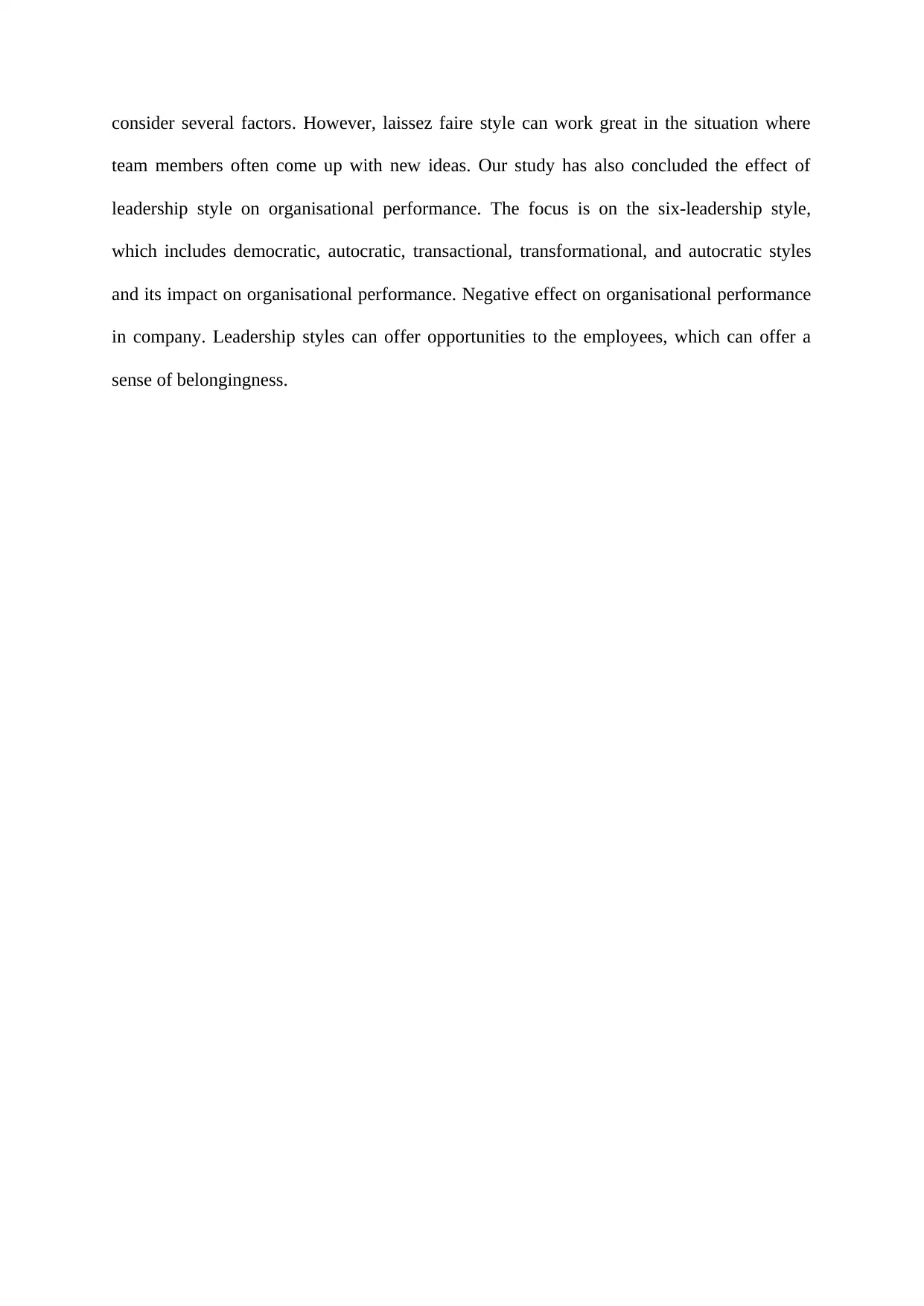
consider several factors. However, laissez faire style can work great in the situation where
team members often come up with new ideas. Our study has also concluded the effect of
leadership style on organisational performance. The focus is on the six-leadership style,
which includes democratic, autocratic, transactional, transformational, and autocratic styles
and its impact on organisational performance. Negative effect on organisational performance
in company. Leadership styles can offer opportunities to the employees, which can offer a
sense of belongingness.
team members often come up with new ideas. Our study has also concluded the effect of
leadership style on organisational performance. The focus is on the six-leadership style,
which includes democratic, autocratic, transactional, transformational, and autocratic styles
and its impact on organisational performance. Negative effect on organisational performance
in company. Leadership styles can offer opportunities to the employees, which can offer a
sense of belongingness.
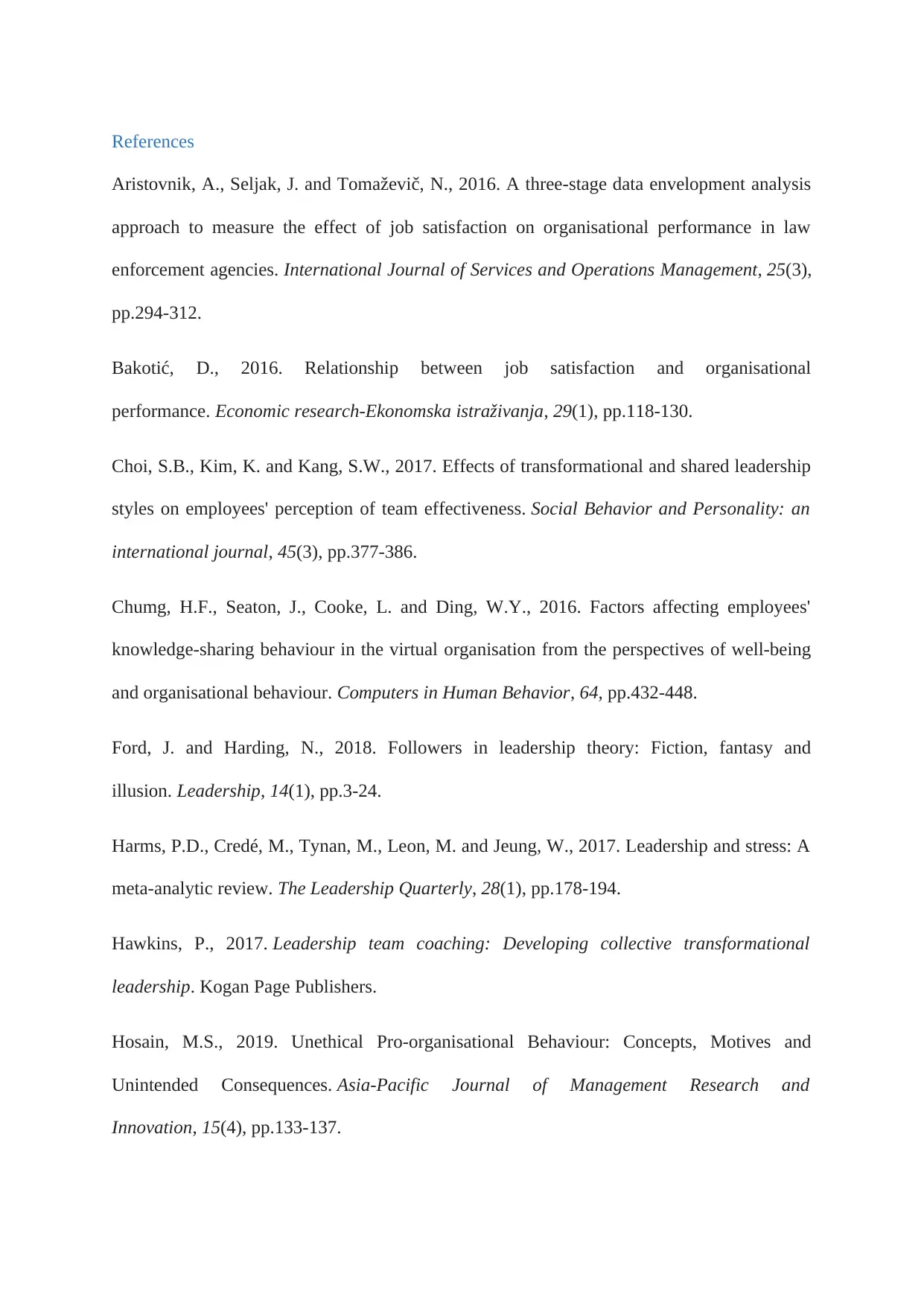
References
Aristovnik, A., Seljak, J. and Tomaževič, N., 2016. A three-stage data envelopment analysis
approach to measure the effect of job satisfaction on organisational performance in law
enforcement agencies. International Journal of Services and Operations Management, 25(3),
pp.294-312.
Bakotić, D., 2016. Relationship between job satisfaction and organisational
performance. Economic research-Ekonomska istraživanja, 29(1), pp.118-130.
Choi, S.B., Kim, K. and Kang, S.W., 2017. Effects of transformational and shared leadership
styles on employees' perception of team effectiveness. Social Behavior and Personality: an
international journal, 45(3), pp.377-386.
Chumg, H.F., Seaton, J., Cooke, L. and Ding, W.Y., 2016. Factors affecting employees'
knowledge-sharing behaviour in the virtual organisation from the perspectives of well-being
and organisational behaviour. Computers in Human Behavior, 64, pp.432-448.
Ford, J. and Harding, N., 2018. Followers in leadership theory: Fiction, fantasy and
illusion. Leadership, 14(1), pp.3-24.
Harms, P.D., Credé, M., Tynan, M., Leon, M. and Jeung, W., 2017. Leadership and stress: A
meta-analytic review. The Leadership Quarterly, 28(1), pp.178-194.
Hawkins, P., 2017. Leadership team coaching: Developing collective transformational
leadership. Kogan Page Publishers.
Hosain, M.S., 2019. Unethical Pro-organisational Behaviour: Concepts, Motives and
Unintended Consequences. Asia-Pacific Journal of Management Research and
Innovation, 15(4), pp.133-137.
Aristovnik, A., Seljak, J. and Tomaževič, N., 2016. A three-stage data envelopment analysis
approach to measure the effect of job satisfaction on organisational performance in law
enforcement agencies. International Journal of Services and Operations Management, 25(3),
pp.294-312.
Bakotić, D., 2016. Relationship between job satisfaction and organisational
performance. Economic research-Ekonomska istraživanja, 29(1), pp.118-130.
Choi, S.B., Kim, K. and Kang, S.W., 2017. Effects of transformational and shared leadership
styles on employees' perception of team effectiveness. Social Behavior and Personality: an
international journal, 45(3), pp.377-386.
Chumg, H.F., Seaton, J., Cooke, L. and Ding, W.Y., 2016. Factors affecting employees'
knowledge-sharing behaviour in the virtual organisation from the perspectives of well-being
and organisational behaviour. Computers in Human Behavior, 64, pp.432-448.
Ford, J. and Harding, N., 2018. Followers in leadership theory: Fiction, fantasy and
illusion. Leadership, 14(1), pp.3-24.
Harms, P.D., Credé, M., Tynan, M., Leon, M. and Jeung, W., 2017. Leadership and stress: A
meta-analytic review. The Leadership Quarterly, 28(1), pp.178-194.
Hawkins, P., 2017. Leadership team coaching: Developing collective transformational
leadership. Kogan Page Publishers.
Hosain, M.S., 2019. Unethical Pro-organisational Behaviour: Concepts, Motives and
Unintended Consequences. Asia-Pacific Journal of Management Research and
Innovation, 15(4), pp.133-137.
⊘ This is a preview!⊘
Do you want full access?
Subscribe today to unlock all pages.

Trusted by 1+ million students worldwide
1 out of 14
Related Documents
Your All-in-One AI-Powered Toolkit for Academic Success.
+13062052269
info@desklib.com
Available 24*7 on WhatsApp / Email
![[object Object]](/_next/static/media/star-bottom.7253800d.svg)
Unlock your academic potential
Copyright © 2020–2025 A2Z Services. All Rights Reserved. Developed and managed by ZUCOL.





